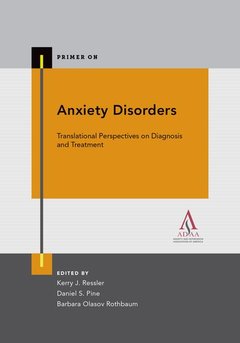Description
Anxiety Disorders
Primer On Series
Coordinators: Ressler Kerry J., Pine Daniel S., Rothbaum Barbara Olasov
Language: English
Subject for Anxiety Disorders:
Publication date: 05-2015
528 p. · 17.8x25.3 cm · Paperback
528 p. · 17.8x25.3 cm · Paperback
Description
/li>Biography
/li>
Anxiety affects millions, manifesting as generalized anxiety disorder (GAD), obsessive compulsive disorder, panic disorder, phobias, post-traumatic-stress disorder (PTSD), and social anxiety disorder. Not only are anxiety disorders common, but they are also crippling, frequently co-occurring and predict high risk for depressive disorders. Shared mechanisms may explain the overlapping features of many anxiety disorders and account for associations with other highly-impairing conditions, such as major depression and substance use. Beyond risk for specific disorders, anxiety also predicts a number of other adverse outcomes, including suicidal behavior, medical problems, social, and economic difficulties. Conversely, disorder-specific mechanisms may also exist and explain the unique features of each syndrome. Thus, it is important to understand both shared and specific aspects of anxiety. The Primer on Anxiety Disorders provides early-stage practitioners and trainees, as well as seasoned clinicians and researchers, with need-to-know knowledge on diagnosis and treatment. Clinical cases are used throughout the book to enhance understanding of and illustrate specific disorders, comorbid conditions and clinical issues. To facilitate an integrative approach, content allows clinicians to understand patient characteristics and tailor interventions. The integrated approach of each chapter includes recent research on genetics and neuroscience to understand the mechanisms of anxiety disorders, focusing on the forthcoming new nosology in DSM-5. Chapters further integrate innovative advances in clinical research providing research on a range of discoveries regarding biomarkers of illness, biological predictors of treatments and the effect of treatment on neurocircuitry.
Kerry J. Ressler, Professor of Psychiatry and Behavioral Sciences at Emory University, received his B.S. degree in molecular biology from M.I.T., and his M.D./Ph.D. from Harvard Medical School. His work focuses on translational research bridging molecular neurobiology in animal models with human genetic research. His basic and clinical research examines neurobiological, molecular, genetic and behavioral processes that underlie fear related processing and Posttraumatic Stress Disorder. Dr. Daniel S. Pine is Chief, Section on Development and Affective Neuroscience, in the National Institute of Mental Health Intramural Research Program. Since graduating from medical school at the University of Chicago, Dr. Pine has been engaged continuously in research on pediatric mental disorders. Currently, his group examines the degree to which mood and anxiety disorders in children and adolescents are associated with abnormalities in the amygdala, prefrontal cortex, and brain regions that modulate these structures. Barbara Olasov Rothbaum, Ph.D. is a professor in psychiatry and Associate Vice Chair of Clinical Research at the Emory School of Medicine in the Department of Psychiatry and Behavioral Sciences and director of the Trauma and Anxiety Recovery Program at Emory. Dr. Rothbaum specializes in research on the treatment of individuals with anxiety disorders, particularly focusing on Posttraumatic Stress Disorder (PTSD).
© 2024 LAVOISIER S.A.S.

